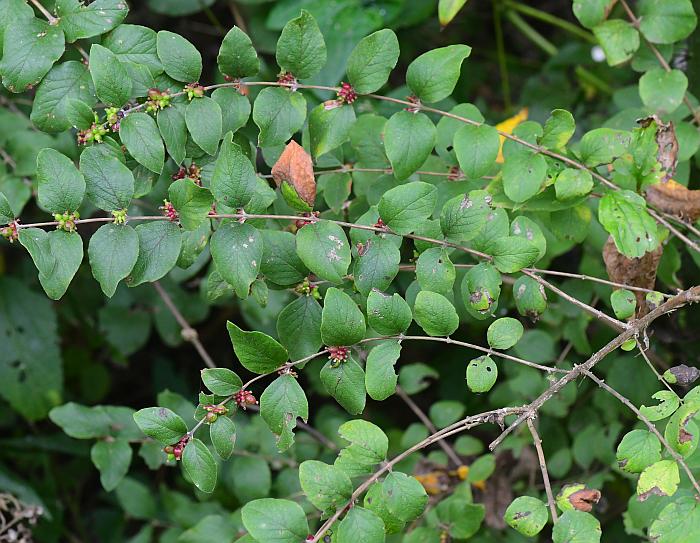Symphoricarpos orbiculatus Moench
Coralberry, Buckbrush

Native
CC = 1
CW = 3
MOC = 79
© SRTurner
Symphoricarpos orbiculatus MoenchCoralberry, Buckbrush | |
 |
Native CC = 1 CW = 3 MOC = 79 |
© SRTurner |
|
Family - Caprifoliaceae Habit - Small shrubs to 1.2 m tall, sometimes colonial from rhizomes. Stems - Young twigs short-hairy, later becoming glabrous. Bark gray to grayish brown, thin, tending to become shredded or occasionally peeling in thin plates.
Leaves - Opposite, simple, entire, short-petiolate. Petioles 2-3 mm long. Leaf blades 1.0-4.5 cm long, 8-28 mm wide, elliptic to ovate or oblong, broadly rounded or broadly angled at the base, rounded or angled to a bluntly or less commonly sharply pointed tip, the upper surface bright green to dark green, the undersurface pale green, short-hairy.
Inflorescences - Dense axillary clusters of flowers. Individual flowers mostly sessile, subtended by a pair of small bractlets.
Flowers - Calyx lobes 0.5-0.8 mm long, triangular to narrowly triangular. Corollas 3-4 mm long, actinomorphic, bell-shaped with a cup-shaped tube about 2-5 mm long and a spreading, 5-lobed portion extending about 1/3 of the way to the base, greenish white and usually purplish-tinged. Stamens with the anthers 0.9-1.2 mm long, not or only slightly exserted from the corolla. Style 3-7 mm long, hairy.
Fruits - Berrylike drupes 3-4 mm in diameter, roughly spherical, pink to reddish purple or purple, rarely white. Seedlike nutlets or stones 2.5-3.2 mm long, elliptic to oblong-elliptic in outline, more or less rounded at each end.
Flowering - July - August. Habitat - Forests, bluffs, streambanks, margins of upland prairies, pastures, fields, fencerows, railroads, roadsides. Origin - Native to the U.S. Lookalikes - Callicarpa americana. Other info. - This small, inconspicuous shrub occurs across Missouri. Its larger range includes most of the Midwest and extends into New England. It is identified by its arching branches of opposite, broadly elliptic leaves and axillary clusters of small, greenish flowers. The plant is easily identified vegetatively with some practice. It is perhaps easiest to identify in the fall, when the stems bearing clusters of pinkish berries are a common woodland sight. The clusters of fruits are somewhat reminiscent of the beautyberry (Callicarpa americana), though the flowers and leaves of that species are very different. Photographs taken at Young Conservation Area, Jefferson County, MO, 8-17-2020, Pea Ridge Conservation Area, Washington County, MO, 9-18-2020, and near Labadie, Franklin County, MO, 9-24-2020 (SRTurner). |